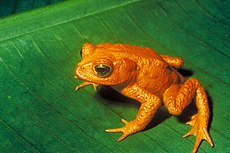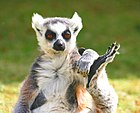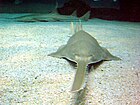Vulnerable species
Conservation status by IUCN Red List category | |
|---|---|
 | |
| Extinct | |
|
|
| Threatened | |
|
|
| Lower Risk | |
|
|
Other categories | |
|
|
Related topics
| |
  | |
A vulnerable species is one which has been categorized by the International Union for Conservation of Nature as likely to become endangered unless the circumstances that are threatening its survival and reproduction improve.
Vulnerability is mainly caused by habitat loss or destruction of the species home. Vulnerable habitat or species are monitored and can become increasingly threatened. Some species listed as "vulnerable" may be common in captivity, an example being the military macaw.
There are currently 5196 animals and 6789 plants classified as vulnerable, compared with 1998 levels of 2815 and 3222, respectively.[1]
Practices such as Cryoconservation of animal genetic resources have been enforced in efforts to conserve vulnerable breeds of livestock specifically.
Contents
1 Criteria
2 See also
3 Notes and references
4 External links
Criteria
The International Union for Conservation of Nature uses several criteria to enter species in this category. A taxon is Vulnerable when it is not critically endangered or Endangered but is facing a high risk of extinction in the wild in the medium-term future, as defined by any of the following criteria (A to E):
A) Population reduction in the form of either of the following:
- An observed, estimated, inferred or suspected population size reduction of ≥ 50% over the last 10 years or three generations, whichever is the longer, provided the causes of the reduction are clearly reversible AND understood AND ceased.[2] This measurement is based on (and specifying) any of the following:
- direct observation
- an index of abundance appropriate for the taxon
- a decline in area of occupancy, extent of occurrence or quality of habitat
- actual or potential levels of exploitation
- the effects of introduced taxa, hybridisation, pathogens, pollutants, competitors or parasites.
- A reduction of at least 20%, projected or suspected to be met within the next ten years or three generations, whichever is the longer, based on (and specifying) any of (2), (3), (4) or (5) above.
B) Extent of occurrence estimated to be less than 20,000 km2 or area of occupancy estimated to be less than 2000 km2, and estimates indicating any two of the following:
- Severely fragmented or known to exist at no more than ten locations.
- Continuing decline, inferred, observed or projected, in any of the following:
- extent of occurrence
- area of occupancy
- area, extent or quality of habitat
- number of locations or subpopulations
- number of mature individuals
- Extreme fluctuations in any of the following:
- extent of occurrence
- area of occupancy
- number of locations or subpopulations
- number of mature individuals
C) Population estimated to number fewer than 10,000 mature individuals and either:
- An estimated continuing decline of at least 10% within 10 years or three generations, whichever is longer, or
- A continuing decline, observed, projected, or inferred, in numbers of mature individuals and population structure in the form of either:
- severely fragmented (i.e. no subpopulation estimated to contain more than 1000 mature individuals)
- all mature individuals are in a single subpopulation
D) Population very small or restricted in the form of either of the following:
- Population estimated to number less than 1000 mature individuals.
- Population is characterised by an acute restriction in its area of occupancy (typically less than 20 km2)[2] or in the number of locations (typically less than five). Such a taxon would thus be prone to the effects of human activities (or stochastic events whose impact is increased by human activities) within a very short period of time in an unforeseeable future, and is thus capable of becoming Critically Endangered or even Extinct in a very short period.
E) Quantitative analysis showing the probability of extinction in the wild is at least 10% within 100 years.
The examples of vulnerable animal species are hyacinth macaw, mountain zebra, gaur, kea, black crowned crane and blue crane
See also
Category:IUCN Red List vulnerable species for an alphabetical list- Cryoconservation of animal genetic resources
- List of vulnerable amphibians
- List of vulnerable arthropods
- List of vulnerable birds
- List of vulnerable fishes
- List of vulnerable insects
- List of vulnerable invertebrates
- List of vulnerable mammals
- List of vulnerable molluscs
- List of vulnerable reptiles
Notes and references
^ IUCN (2012). "IUCN Red List version 2012.2: Table 2: Changes in numbers of species in the threatened categories (CR, EX, VU) from 1996 to 2012 (IUCN Red List version 2012.2) for the major taxonomic groups on the Red List" (PDF). Retrieved 2012-12-31..mw-parser-output cite.citationfont-style:inherit.mw-parser-output qquotes:"""""""'""'".mw-parser-output code.cs1-codecolor:inherit;background:inherit;border:inherit;padding:inherit.mw-parser-output .cs1-lock-free abackground:url("//upload.wikimedia.org/wikipedia/commons/thumb/6/65/Lock-green.svg/9px-Lock-green.svg.png")no-repeat;background-position:right .1em center.mw-parser-output .cs1-lock-limited a,.mw-parser-output .cs1-lock-registration abackground:url("//upload.wikimedia.org/wikipedia/commons/thumb/d/d6/Lock-gray-alt-2.svg/9px-Lock-gray-alt-2.svg.png")no-repeat;background-position:right .1em center.mw-parser-output .cs1-lock-subscription abackground:url("//upload.wikimedia.org/wikipedia/commons/thumb/a/aa/Lock-red-alt-2.svg/9px-Lock-red-alt-2.svg.png")no-repeat;background-position:right .1em center.mw-parser-output .cs1-subscription,.mw-parser-output .cs1-registrationcolor:#555.mw-parser-output .cs1-subscription span,.mw-parser-output .cs1-registration spanborder-bottom:1px dotted;cursor:help.mw-parser-output .cs1-hidden-errordisplay:none;font-size:100%.mw-parser-output .cs1-visible-errorfont-size:100%.mw-parser-output .cs1-subscription,.mw-parser-output .cs1-registration,.mw-parser-output .cs1-formatfont-size:95%.mw-parser-output .cs1-kern-left,.mw-parser-output .cs1-kern-wl-leftpadding-left:0.2em.mw-parser-output .cs1-kern-right,.mw-parser-output .cs1-kern-wl-rightpadding-right:0.2em
^ ab http://www.iucnredlist.org/static/categories_criteria_3_1#critical
External links
List of Vulnerable species as identified by the IUCN Red List of Threatened Species



